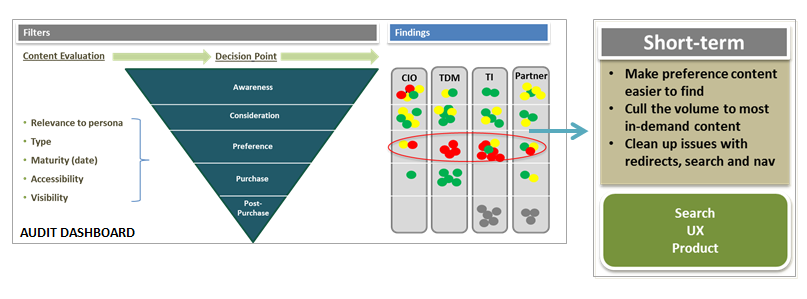 In modern marketing, journeys replace the traditional funnel as a more dynamic tool that provides insights into each member of a buying team. The funnel is too linear for today’s more active and self-directed buying cycles. People do not move along the path-to-purchase in a straight line or in a defined, predictable manner. They often bounce between buying stages as they evaluate options or bring in the expertise of a team member.
In modern marketing, journeys replace the traditional funnel as a more dynamic tool that provides insights into each member of a buying team. The funnel is too linear for today’s more active and self-directed buying cycles. People do not move along the path-to-purchase in a straight line or in a defined, predictable manner. They often bounce between buying stages as they evaluate options or bring in the expertise of a team member.
We’re still surprised by the number of organizations who ask about the value of journeys and if they really need to do them. Others report that they use their marketing automation platforms to automate their journeys but do not feel they are optimized for personalization. These organizations often fail to go through the arduous (and mostly manual) process of uncovering the information that makes journey automation relevant. While automation is critical for scale, it is only as good as the information it is acting upon.
We use the following definition to help clients understand the underlying value of and approach to the B2B buyers’ journeys.
Buyer’s Journey: A tool that displays insights into buyer needs, information sources, channel and format preferences and level of detail at each point of the path-to-purchase. B2B journeys use a matrixed approach to diagram the path for each person in an enterprise that touch or influence the buying decision. The buyer’s journey defines their needs for specific buying triggers across a robust buying center.
Journeys provide data and insights for a variety of activities, including things like:
- Starting point for segment/role personalization
- Optimization of key word strategy
- Baseline for content audit
- Data for editorial plan for segment/role
- Sourcing plan for new content required (brand generated, partner, UGC, VOC, curated, etc.)
- Insights for taxonomy and content architecture
- Operational plan for the required processes, systems, tools, skill sets and governance
- Insights for lead generation programs
- Channel strategy
- Data for ABM efforts
- Requirements for MarTech stack
Buyer’s Journey Best Practices
Or, what you need to do before you can scale or automate.
Creating a journey starts and ends with customer knowledge. You need to know or find-out who is involved and what their path is for specific buying triggers. Following are a few steps that are required when creating a journey.
- Identify your top five buying triggers or scenarios. These differ by industry and product line and reflect the reason a buyer needs your products or services. The triggers of buyers of financial services or commercial banking products, for example, could include such things as M&A, geographic expansion, need for new or updated facilities or need to invest for better line productivity. A technology buyer, on the other hand, might be compelled by a need for a major tech refresh, the expiration of product licenses, need to increase productivity or reduce costs of the data center.
- Specify the buying center for each trigger. Today, teams, not individuals, make purchasing decisions. It is important to understand the roles of all who touch the buying decision and have detailed persona information for each.
- Create a journey for each role for each trigger. A good starting point here is the information gleaned from the persona research coupled with keyword research that is trigger specific. These two pieces of information give you the momentum to start a journey and follow each role along their path. Viewing the results for each role in parallel swim lanes gives insights into how you fare as an organization in providing each with relevant content that is deep and meaningful.
- Audit existing content against journey map. This data can be depicted as a “report card” that guides what type of content should be included in editorial calendar for each persona/role. The one below is an illustration for an enterprise technology decision. It shows where content resources should be focused and where the low hanging fruit can be plucked for immediate impact.

- Expand enterprise content strategy. The journey work can provide multiple inputs for your organizations enterprise content strategy. We often overlay multiple journeys to identify systemic issues in processes, systems and governance. We also use the information supplied by the journey to inform the sourcing model and determine the right skill sets needed by the organization to actualize its strategy.
Another consideration is understanding the impact of type and length of journey on content needs. Example: A shorter buying cycle requires more intense content delivery and a deeper realization of when a buyer is in heavy research mode. It is essential to view your journey maps as dynamic documents that offer a snapshot in time for a specific buying trigger. The more journeys you do, the better you’ll know the people who are making decisions and how they behave when they are serious about buying. Once this information is captured, your automation platform can help scale the process and make your personalized experiences more relevant and meaningful.

Principal
Engaging your customers is at the heart of successful marketing programs. For more than 20 years, Cheryl has been building and executing content and thought leadership strategies designed to do just that. She is excited to be applying that well-honed skill to a help companies like Microsoft, Cisco, 3M, Intel, Capital One and Barclaycard tap into their stakeholder communities and build sophisticated content strategies.
Her experience base spans a range of industries – from technology and financial services to retail, travel, consumer products and healthcare. Cheryl has served as an integral member of her clients’ marketing teams, providing counsel on marketing and brand strategy, thought leadership, media relations, product introductions, and event management.
Prior to joining ComBlu, Cheryl spent 10 years leading corporate marketing for large, complex organizations.
